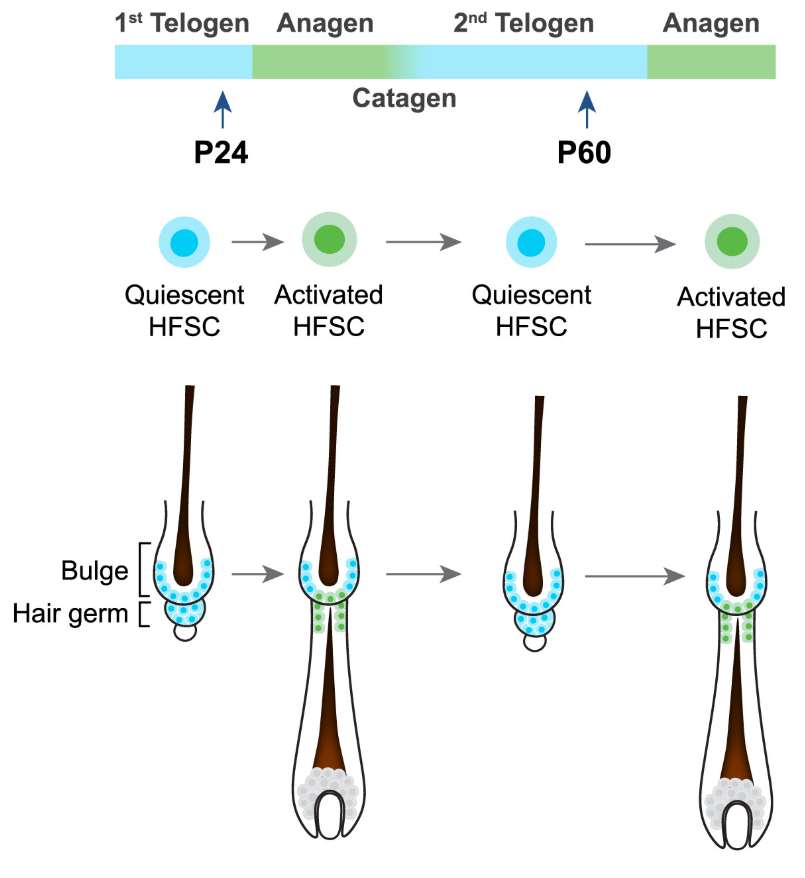Fasting has been a part of human culture for centuries, practiced by various groups for religious and health purposes. In modern times, intermittent fasting has gained popularity for its potential benefits, including weight control and improved metabolic health.
Emerging evidence suggests fasting also influences tissue health by interacting with somatic stem cells, which are critical for tissue maintenance and regeneration. However, the mechanisms driving these effects remain unclear.
Somatic stem cells are housed in specialized microenvironments called niches, which integrate signals from the body and environment to regulate cell behavior. This system enables tissues to adapt to physiological and environmental changes, crucial for survival.
While fasting is known to improve stem cell function in the intestine, muscle, and blood systems, its effects on other tissues, such as skin, have been less explored. The skin’s hair follicles, which undergo cycles of growth, regression, and rest, are driven by hair follicle stem cells (HFSCs).

These cells provide a unique opportunity to study fasting’s effects on stem cells and tissue biology due to their well-defined behavior and visible outcomes like hair growth.
Recent research has delved into how intermittent fasting impacts HFSCs and hair regeneration. A study published in Cell revealed that intermittent fasting, while improving metabolic health, could slow hair regrowth in mice.
Mice subjected to fasting regimens, such as time-restricted feeding (8 hours of food access followed by 16 hours of fasting) or alternate-day fasting, exhibited delayed hair regrowth compared to mice with unrestricted food access. Over 96 days, fasting mice showed only partial hair regrowth, while control mice regrew most of their hair within 30 days.
This slowed regrowth is linked to HFSCs’ inability to handle oxidative stress during fasting. When fasting, the body shifts from glucose to fat metabolism, releasing free fatty acids into the bloodstream. These fatty acids accumulate near hair follicles and generate harmful reactive oxygen species within HFSCs.
Related Stories
Unlike epidermal stem cells, which maintain the skin barrier and have a higher antioxidant capacity, HFSCs lack sufficient antioxidant defenses. Consequently, many HFSCs undergo programmed cell death during extended fasting periods, impairing their ability to regenerate hair.
The study further demonstrated that human HFSCs exposed to free fatty acids in vitro also experienced apoptosis. Genetic engineering experiments confirmed that this apoptosis is driven by fatty acid-induced oxidative stress. However, the effects were not uniform across all stem cells.
Epidermal stem cells were unaffected by fasting, highlighting the diversity in metabolic and oxidative stress responses among different stem cell types.
To mitigate fasting’s negative impact on hair regrowth, researchers tested antioxidants. Topical application of vitamin E and genetic enhancements to antioxidant capacity helped HFSCs survive oxidative stress, improving their ability to regenerate hair. These findings suggest potential interventions to counteract fasting’s unintended effects on stem cells.

The team also conducted a small clinical trial involving 49 healthy young adults. Participants followed an 18-hour fasting regimen daily for 10 days. Results showed a modest reduction in hair growth speed—about 18% slower than controls. Although the human effects were milder than in mice, likely due to differences in metabolic rates and hair growth patterns, the study emphasized individual variability.
Lead researcher Bing Zhang of Westlake University noted, “The human population is very heterogeneous, so the effects might be different for different people. Mice have a very high metabolic rate, so fasting impacts their HFSCs more severely. In humans, we see a milder effect with some hair regrowth still occurring, just slower.”
These findings underline the complexity of fasting’s impact on the body. While fasting offers numerous health benefits, such as improved metabolic function and enhanced stress resistance of some stem cells, it may also have unintended consequences on specific tissues like skin and hair.
Zhang’s team plans to expand their research, investigating how fasting affects other skin stem cells and exploring its role in wound healing and tissue regeneration. They aim to identify metabolites that could protect HFSCs and promote hair growth during fasting, potentially paving the way for therapeutic applications.

The implications of this research extend beyond aesthetics. Hair growth is a visible marker of underlying biological processes, and understanding how fasting influences HFSCs could provide insights into broader stem cell biology.
As Zhang remarked, “We want to figure out how fasting impacts regeneration activities in other tissues and identify ways to harness its benefits while minimizing drawbacks.”
For now, intermittent fasting remains a powerful tool for metabolic health, but awareness of its effects on stem cells and tissue health is essential.
With further research, strategies to optimize fasting’s benefits while addressing its limitations may emerge, offering new avenues for improving overall health and well-being.
Note: Materials provided above by The Brighter Side of News. Content may be edited for style and length.
Like these kind of feel good stories? Get The Brighter Side of News’ newsletter.
The post Intermittent fasting could be detrimental to hair growth, study finds appeared first on The Brighter Side of News.